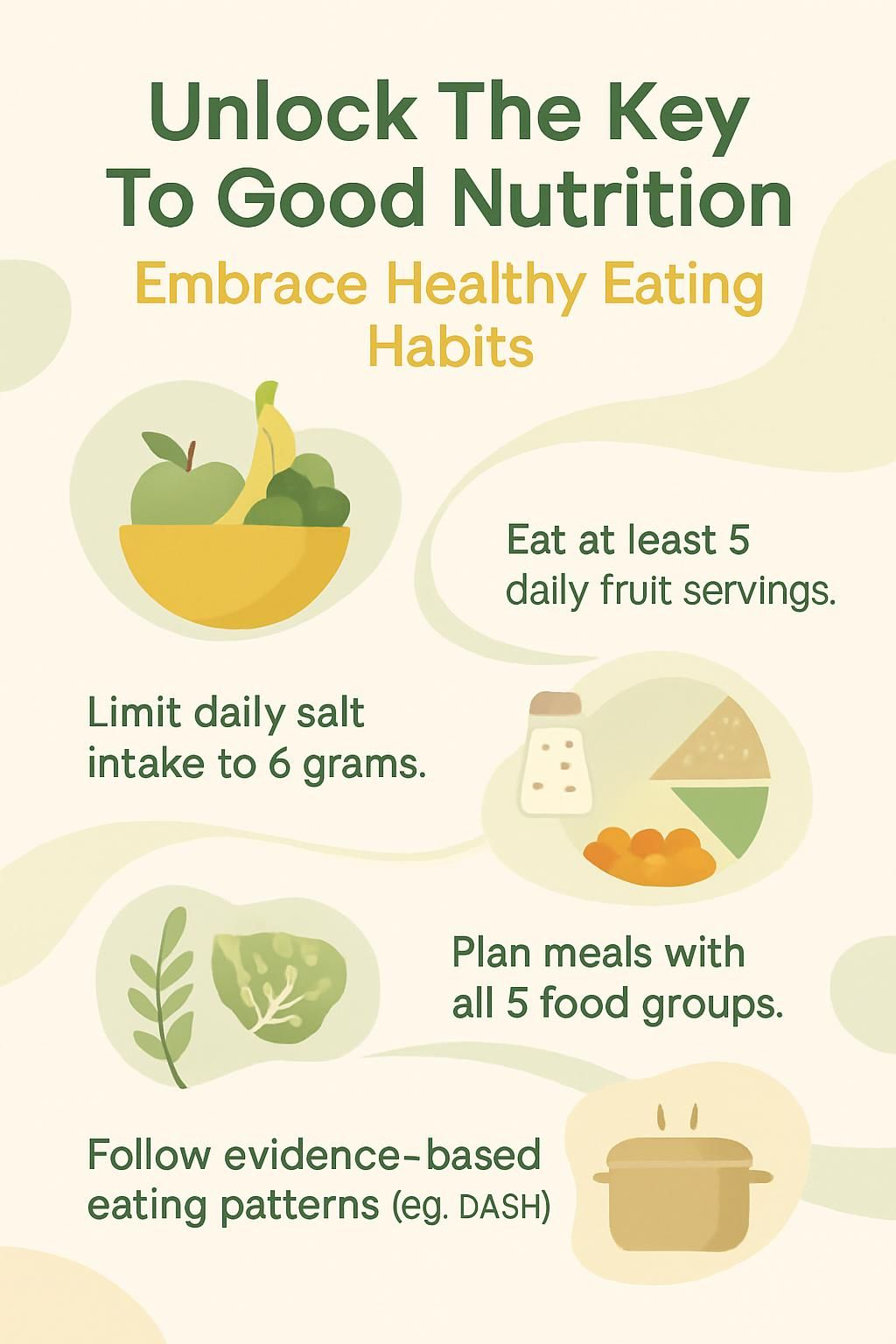Unlock The Key To Good Nutrition: Embrace Healthy Eating Habits
Our Nutrition Assistant AI Suite will transform your body. You will lose fat, get toned, and build muscle. Gain confidence and optimal health.
You face a flood of advice about what to eat. Good nutrition simply means giving your body the right mix of foods so you can grow, heal, think clearly, and stay active. A healthy diet supports your daily life and long-term health.
This guide explains what good nutrition looks like, offers simple healthy eating habits, and shows how better choices can lower disease risk. Start with one change today and build from there.
Key Takeaways
- Eating a balanced diet, including at least five servings of fruits and vegetables daily, whole grains, lean proteins, and healthy fats, lowers your risk for heart disease, type 2 diabetes, unhealthy weight gain, and some cancers (USDA Dietary Guidelines 2020–2025).
- Limit daily salt to 6 grams, about one teaspoon, and cut added sugars. Read Nutrition Facts to track sodium and sugar.
- Plan meals that include all five food groups. Portion sizes matter since many men need about 2,500 calories per day and many women need about 2,000.
- Evidence-based patterns such as DASH or the Eatwell Guide support energy, mental focus, and immune health while reducing chronic disease risk at every age.
- Cooking most meals at home with fresh or minimally processed foods saves money and improves nutrition quality, according to CDC guidance as of 2023.

Understanding Good Nutrition

Good nutrition shapes your health at every age. A healthy diet delivers vitamins, minerals, and other nutrients your body needs to move, think, and repair itself.
What does good nutrition mean?
Nutrition means getting the right amounts of nutrients so your body can work well. You meet those needs with a balanced plate that includes vegetables, fruit, whole grains, lean protein, and healthy fats.
Each nutrient has a job. Vitamins and minerals support your immune system. Fiber from beans and whole-wheat bread supports digestion and helps lower cholesterol.
Nutritious meals reduce the risk of heart disease, type 2 diabetes, unhealthy weight gain, and certain cancers. The USDA suggests filling half your plate with fruits and vegetables most meals.
Cutting back on salt and sugar helps prevent high blood pressure and insulin spikes. Many people notice better energy when they swap sugary drinks and snacks for whole foods.
Nutrition is eating the right mix and amount of nutrients so your body works at its best.
Why is a balanced diet important?
A balanced diet helps you maintain a healthy weight and lowers risk for heart disease and stroke. Meals that include produce, lean proteins like fish or tofu, whole grains such as brown rice or oats, and low-fat dairy give your body steady fuel.
Starchy foods like potatoes or yams provide energy you can use through the day. The Academy of Nutrition and Dietetics notes that tools like the Eatwell Guide can help you picture the right proportions of each food group.
Balanced eating supports your immune system and speeds recovery after illness or injury. Research links strong dietary patterns with lower rates of hypertension and chronic kidney disease.
Variety also prevents vitamin and mineral shortfalls that affect children’s growth and adult health. Government resources from the Department of Agriculture advise limiting saturated fat and trans fat, added sugars from juices or sweetened cereals, and sodium from processed foods to reduce disease risk.
Key Components of a Nutritious Diet
Healthy eating starts with what you put on your plate most days. Choosing safe and nutrient-dense foods can lower the risk of heart disease and obesity.
Why are fruits and vegetables essential?
Fruits and vegetables add fiber, vitamins, and minerals to your meals. The Department of Health and Human Services encourages at least five portions per day.
One portion equals 80 grams for fresh, canned, or frozen produce, 30 grams for dried fruit, or a 150 milliliter serving of juice or a smoothie. Diets rich in apples, oranges, leafy greens, carrots, and squash can lower cardiovascular risk.
These foods are low in calories and high in vitamin C, potassium, magnesium, and antioxidants. Fiber also supports regular digestion.
I swapped processed snacks for apples with peanut butter and felt more focused within a week. Dietitian Dr. Maria Johnson reminds her patients, every snack can move you closer to your goals.
Eating the rainbow each day gives your body what it truly needs.
What are the benefits of whole grains?
Whole grains, like whole-wheat pasta and brown rice, offer more fiber and nutrients than refined grains. Fiber keeps digestion regular and helps you feel full longer.
The Dietary Guidelines for Americans recommend that at least half of your grains be whole. Staples such as oats and maize can also lower the risk of heart disease and type 2 diabetes.
When I switched from white bread to whole grain, my midmorning cravings eased, and my energy lasted longer.
Studies show higher fiber intake links to lower rates of several chronic conditions[1]. Small swaps you repeat daily can add up to real health gains.
…
[1] U.S. Department of Health & Human Services, Dietary Guidelines for Americans,
2020-2025
Which lean proteins should you choose?
Choose lean proteins such as seafood, skinless poultry, eggs, and legumes. Health experts suggest eating fish twice a week. Include one serving of oily fish, like salmon or mackerel, for omega-3 fats.
Soy foods, nuts, and seeds offer plant-based protein with less saturated fat. Lean meats trimmed of visible fat supply iron and zinc without many extra calories.
Meals that fit the DASH diet might include grilled chicken, lentil soup, or a tofu stir-fry. Rotate options to keep meals enjoyable and balanced.
Protein supports muscles, hormones, and daily body functions. Many people pair protein with whole grains for steady energy and better satisfaction.
How do healthy fats support your body?
Healthy fats store energy, help absorb vitamins A, D, E, and K, and support cell health. Unsaturated fats from olive oil, canola oil, nuts, and avocado are better choices than saturated fats found in butter and fatty meats.
Replacing saturated fat with unsaturated fat can lower heart disease risk. General guidance suggests limiting saturated fat to about 10 percent of daily calories, with lower targets for some people.
Olive oil on salads or avocado on toast can replace processed dressings and spreads. I swapped chips for roasted soybeans at lunch and noticed steadier energy all afternoon.
How much sugar and sodium should you consume?
Most adults should keep salt to 6 grams per day, about one teaspoon. Since much of the sodium you eat comes from packaged foods, read labels on bread, cheese, sauces, and soups.
Limit added sugars by choosing water or unsweetened drinks instead of regular soda or juice. Too much sugar or sodium raises the risk of high blood pressure and excess weight.
Meal prepping helped me trade chocolate milk for plain milk without feeling deprived. Build meals around fresh produce, lean protein, and whole grains to stay within healthy limits.
Benefits of Healthy Eating Habits
Healthy eating habits power your day and protect your future. Think of your plate as daily training for your body and mind.
How does healthy eating improve overall well-being?
Nutrient-dense meals cut the risk of type 2 diabetes and heart disease, two common conditions in the United States. Vegetables and other whole foods provide minerals that help your body repair after illness or surgery.
Balanced eating stabilizes blood sugar, which supports mood and brain function. Many people report higher energy when they follow a consistent, healthful pattern.
Choosing whole grains, lean proteins, and healthy fats gives steady fuel for work, school, and play. Lower sugar and sodium support heart health and reduce energy crashes.
During breastfeeding with my second child, planning simple, balanced meals improved stamina and immune health. My clinician also saw strong nutrition markers in my milk.
Can healthy eating boost your immune system?
Food is your first line of defense. Vitamin A supports your immune system and vision. Include orange vegetables like sweet potato and squash for a boost.
Vitamin C aids tissue growth and wound healing. Citrus fruit and bell peppers are easy ways to meet your needs. Zinc also supports immune function and can be found in poultry, beans, and seeds.
When I replaced extra sweets with fruits, vegetables, and whole grains, I noticed fewer sick days. Nutritious meals work with medicine, they do not replace medical care.
How does diet reduce chronic disease risks?
Healthy eating habits protect your heart and blood vessels. Fruits, vegetables, whole grains, and lean proteins deliver potassium, calcium, and other minerals that support blood pressure control.
Dietary fiber improves cholesterol levels and can lower the risk of diabetes and stroke. Many people in the United States fall short on vitamin D and potassium, two nutrients linked with long-term health.
Reducing added sugar and sodium lowers risk across time. After I started reading food labels, cutting salty snacks helped my blood pressure reach a healthier range.
What impact does nutrition have on energy and mental clarity?
Carbohydrates are your main energy source. B vitamins help your body turn food into energy your brain can use.
When you eat balanced meals rich in whole grains, lean protein, and produce, energy and mood feel more steady. Research suggests good nutrition supports mental health through brain-friendly nutrients.
Once I added more fruit and healthy fats to my meals, afternoon slumps faded. My focus and memory improved during study sessions.
Effective Strategies for Healthy Eating
Small, repeatable steps create big results. A little planning today can make healthy choices automatic tomorrow.
How can you plan and prepare healthy meals?
Planning sets you up for success. These steps make balanced cooking simple.
- Start a weekly plan that uses five food groups, dairy, fruits, grains, proteins, and vegetables. Dietitians recommend this approach to meet core nutrient needs.
- Build a grocery list from your plan to avoid impulse buys. Add whole grains, fresh produce, lean proteins, and low-fat dairy to cover key nutrients.
- Save an hour on weekends to batch-cook or prep ingredients like chopped vegetables and washed greens.
- Limit items high in added sugar and sodium. Use labels to choose products with lower values, aiming for sodium under 2,300 mg per day, as the CDC advised in 2023.
- Cook most meals at home with minimally processed foods. You gain control over portions, calories, and variety.
- Stock easy snacks like carrots, apples with nut butter, and plain Greek yogurt for quick, nutritious bites.
- Drink water regularly to support digestion, energy, and nutrient absorption.
When I started prepping lunches on Sundays, I cut fast-food costs in half within two months and felt more energetic at school.
Why include a variety of food groups?
Variety helps you cover all your bases. Each group delivers different nutrients your body needs to thrive.
- Food groups supply vitamins, minerals, carbohydrates, fats, and proteins. Together, they maintain health.
- Eating many types of foods ensures you get both macronutrients and micronutrients. The Dietary Guidelines for Americans recommend all five groups daily.
- Vitamin A often comes from carrots and spinach. Vitamin C from oranges and strawberries. Iron from beans and lean beef. Calcium from milk and cheese.
- Fortified foods add vitamins or minerals to help fill gaps. Breakfast cereals may include added B vitamins and iron.
- Diverse diets lower chronic disease risk and support healthy blood pressure and cholesterol.
- Nuts offer healthy fats and leafy greens deliver fiber, a powerful duo for heart and gut health.
- More whole foods leave less space for sugary or salty snacks.
- A mix of foods keeps meals interesting, which makes healthy habits easier to keep.
- Growing children need a range of nutrients. Adults benefit from balance to sustain energy through the day.
- Tracking servings of each group helps you spot gaps. Aiming for five servings of fruits and vegetables daily improves outcomes, according to the CDC.
Choosing many types of foods makes every meal count toward long-term wellness.
How do you manage portion sizes effectively?
Portions in restaurants are often large. Smart portion habits help prevent overeating at home and away.
- Use smaller plates and bowls to guide serving sizes.
- Read serving size information on packages. It sets a helpful baseline.
- Serve 80 g of fresh, canned, or frozen fruits and vegetables or 30 g of dried fruit for a portion.
- Limit juice and smoothies to 150 ml to control added sugars.
- Fill half your plate with vegetables or salad, then add protein and grains.
- Measure snacks like nuts or trail mix with a measuring cup. Avoid eating straight from the bag.
- Eat slowly. Give your body time to notice fullness.
- Use daily calorie needs as a guide. Many men need about 2,500 calories and many women need about 2,000.
- Pack leftovers into single-serve containers right after meals to reduce second helpings.
Portion awareness supports nutrient balance and steady energy.
What are the best fresh and minimally processed options?
Fresh and minimally processed foods deliver more nutrients and fewer extras like added sugar, salt, and unhealthy fats. Build meals from these staples.
- Fresh fruits such as apples, oranges, and berries provide vitamins and fiber without added sugars. Rinse before eating.
- Leafy greens like spinach, kale, and romaine are low in calories and rich in nutrients. Enjoy them raw or cooked.
- Whole grains including brown rice, quinoa, and oats contain fiber that helps manage blood sugar.
- Lean proteins such as chicken breast, turkey, fish, beans, and eggs supply essential amino acids with less saturated fat.
- Plain low-fat dairy like milk, yogurt, or cottage cheese offers calcium for bone strength with less added sugar.
- Healthy fats from avocados, unsalted nuts, olive oil, and seeds support heart health.
- Vegetables like carrots, peppers, cucumbers, broccoli, and tomatoes shine raw or lightly steamed.
Keeping these foods on hand makes healthy cooking faster and easier. Up next, water, your most useful daily beverage.
How important is staying hydrated with water?
Your body relies on water to function well. Drinking 6 to 8 glasses of fluids each day supports energy, focus, and digestion.
Hydration helps maintain body temperature and healthy skin. Even mild dehydration can cause headaches or fatigue. I notice a clear difference on busy days if I forget my bottle at home.
Make water part of your routine. Keep a refillable bottle within reach and sip often.
Overcoming Challenges to Healthy Eating
Healthy eating can feel tough in real life. A few practical systems can keep you on track even on hard days.
How can you eat healthy on a budget?
Nutritious food can fit your budget with a little planning. Focus on value, versatility, and reducing waste.
- Choose beans, lentils, and peas for low-cost protein, fiber, and iron.
- Buy seasonal produce. It is usually fresher and less expensive.
- Select basic staples such as whole oats or brown rice instead of pricey premade meals.
- Compare prices for milk and fortified plant drinks. Pick options that meet your nutrition needs.
- Shop with a list. It keeps you focused and reduces impulse buys.
- Cook at home. You control ingredients and reduce costs.
- Use leftovers for soups, salads, or wraps so nothing goes to waste.
- Hunt for sales, consider store brands, and use coupons when available.
What are time-saving meal prep tips?
Meal prep trims stress during busy weeks. Use simple systems that you can repeat.
- Pick recipes with whole ingredients and few steps. One-pan meals reduce cleanup.
- Cook grains like brown rice or quinoa in bulk. Freeze portions for later.
- Use frozen vegetables and canned beans to cut chopping time without losing nutrients.
- Batch-cook proteins like chicken breast or tofu. Store safely in airtight containers.
- Wash and chop produce after shopping. Clear containers make healthy choices visible.
- Invest in stackable containers with tight lids for balanced grab-and-go lunches.
- Create a weekly meal plan and stick to a list centered on nutrient-dense foods.
- Set a weekly prep day. Many families like Sunday afternoons.
- Label containers with the date. Most cooked dishes keep safely in the fridge for up to four days according to CDC guidelines^1^.
^1 Centers for Disease Control and Prevention (CDC). “Food Safety,” https://www.cdc.gov/foodsafety/index.html
How do you control cravings and emotional eating?
Cravings are common during stress, boredom, or long gaps between meals. Structure and awareness help you respond instead of react.
- Eat regular, balanced meals from all five food groups to prevent dips in energy.
- Include protein, fiber, and healthy fats at each meal for fullness and steady blood sugar.
- Drink water through the day. Thirst can feel like hunger.
- Prep healthy snacks, such as cut vegetables or unsalted nuts, to avoid sugary or salty options.
- Keep a food and mood log. Notice patterns and triggers.
- Practice mindful eating. Focus on flavor, texture, and hunger cues.
- Manage stress with a walk, reading, or deep breathing instead of reaching for treats.
- Ask for support from friends, family, or a healthcare professional if patterns persist.
Harvard Health Publishing notes that meals with protein, fiber, and healthy fats support satiety. These steps can make daily cravings easier to handle.
Nutrition Needs Across Life Stages
Your nutrition needs change from childhood to older adulthood. The goal stays the same, give your body what it needs, in portions that fit you.
What nutrition do children and teens require?
Children and teens need balanced meals from all five food groups every day. Offer fruits, vegetables, whole grains, lean proteins like chicken, eggs, or beans, and dairy or fortified alternatives.
Young children under 5 should not follow low-fat diets because healthy fats support brain development. For instance, one cup of milk provides about 8 grams of protein plus calcium for bones.
Doctors encourage at least five servings of fruits and vegetables for children ages 4 to 18. Iron from meats or fortified cereals supports learning by moving oxygen through the blood.
With my three kids, adding color to every plate made meals both healthier and more fun. Simple snacks like yogurt or sliced fruit help meet needs without extra sugar or salt.
How to maintain good nutrition during adulthood?
In adulthood, nutrition supports health, performance, and disease prevention. The Dietary Guidelines for Americans recommend a mix of fruits, vegetables, whole grains, lean proteins, and healthy fats like olive oil and avocados.
People who menstruate need more iron from foods like lean meats, beans, and spinach. Many adults also benefit from calcium and vitamin D for bone health.
Track portions with measuring tools to avoid eating more than you need. Choose water over sugary drinks for hydration and fewer calories.
Limit sodium by choosing fresh foods instead of processed ones. The CDC advises less than 2,300 mg per day for most adults. Planning weekly menus has helped me include a wider range of nutrients without extra effort.
What nutritional changes are needed for older adults?
Appetite can decline with age. Small, frequent meals with plenty of fruits and vegetables can help you meet your needs.
Focus on vitamin D and calcium to protect bones past age 65. Add fatty fish, fortified cereals, low-fat dairy, and leafy greens to raise intake.
Drink water regularly since thirst cues weaken over time. Reduce sodium to help manage blood pressure. Choose lean proteins like poultry, beans, or tofu to protect muscle.
These steps support strength and lower the risk of osteoporosis and fractures.
How Nutrition and Physical Activity Work Together
Food and movement work like a team. Each one strengthens the other.
How does exercise improve nutrition benefits?
Exercise helps your body use nutrients more effectively. Activity increases your muscles’ demand for energy, so your body uses carbohydrates and protein better after workouts.
Matching calorie intake to activity helps manage weight. Too many calories cause weight gain, too few can lead to unwanted loss.
After exercise, muscles need protein to repair and grow. Hydration also matters because you lose water through sweat.
I feel steadier through long days when I combine healthy meals with walks or gym sessions. The CDC reports that pairing nutritious diets with daily exercise improves recovery and keeps energy more stable.
What role does nutrition play in fitness goals?
Nutrition fuels workouts and improves results. Protein supports muscle repair and growth. Balanced meals with lean proteins, whole grains, fruits, vegetables, and healthy fats support recovery.
Hydration improves endurance and performance. Water regulates body temperature and supports muscles. Athletes who stay hydrated perform better and recover faster^1^.
If your goal is muscle gain or fat loss, nutrition matters. Protein helps preserve lean mass, while carbohydrates like brown rice and sweet potatoes refill energy stores between sessions.
[1] Sawka MN et al., 2015, Exercise and Fluid Replacement, Medicine & Science in Sports & Exercise
How to Decode Nutritional Labels
Labels can look complex at first. With a few steps, you can spot what matters most.
How do you read and understand food labels?
Food labels list calories and nutrients per serving. Use them to fit foods into your daily plan.
- Start with serving size. All numbers on the label are based on this amount.
- Check calories per serving. Fats contain 9 calories per gram. Carbohydrates and proteins contain 4 per gram.
- Review carbohydrates, fats, and protein. Compare totals to your daily needs.
- Look at sodium, vitamin D, calcium, iron, and potassium. These affect blood pressure, bones, and more.
- Use % Daily Value. Five percent or less is low. Twenty percent or more is high, per FDA guidance.
- Limit added sugars and saturated fats. High intakes link to chronic disease.
- Scan ingredients for hidden sugars or fats, terms like corn syrup or partially hydrogenated oil.
- Pick lower sodium options since many processed foods contain large amounts in a single serving.
- Notice which vitamins or minerals are not listed. Not all are required on every product.
These steps help you choose products that fit a balanced eating pattern.
Where are hidden sugars and fats found on labels?
Many products include sugars and fats under different names. Sugar may appear as high fructose corn syrup, maltose, or dextrose. Fats may show up as partially hydrogenated oils or vegetable oil.
Watch for these in breads, sauces, salad dressings, and ready meals. Seventy percent of sodium comes from packaged foods, which often include added sugars and saturated fats too.
I once bought a soup labeled low fat, then found several added sugars in the ingredients. Careful reading helps you see the full picture.
Common Nutrition Myths and Facts
Myths can derail good choices. Clear facts make daily decisions easier and more sustainable.
What are popular nutrition myths debunked?
A range of popular claims affect what you buy and eat. Use this quick table to separate myths from facts.
| Myth | Fact | Supporting Data / Example |
|---|---|---|
You are what you eatmeans each single food defines your health. | Your health reflects long-term eating patterns, not one food or meal. | USDA guidelines focus on overall patterns rather than single nutrients. |
| Carbohydrates cause weight gain. | Whole grains, fruits, and vegetables are nutrient-dense. Extra calories and refined carbs drive weight gain. | CDC data links whole grain patterns to healthier weights. Refined grains link more to obesity. |
| All fats are bad. | Healthy fats support hormones, brain function, and vitamin absorption. | Harvard experts highlight unsaturated fats from nuts, fish, and avocados for heart health. |
| Eggs always raise cholesterol. | Moderate egg intake does not significantly affect blood cholesterol for most people. | American Heart Association, 2019, allows up to one egg per day in a heart-healthy diet. |
| Gluten-free is healthier for everyone. | Without celiac disease or gluten sensitivity, gluten-free products may lack fiber and key nutrients. | Gastroenterology, 2017, found no general benefit for gluten-free diets. |
| Natural sugars are always safe. | Excess sugar, even from honey or juice, can cause weight gain and metabolic issues. | American Heart Association limits added sugars to 25 g for women and 36 g for men daily. |
| Skipping meals helps you lose weight. | Skipping meals can slow metabolism and lead to overeating later. | Journal of Nutrition, 2015, links regular meal timing to healthier weight and metabolism. |
| Supplements can replace a healthy diet. | Supplements may fill gaps, but whole foods provide fiber and other helpful compounds. | NIH notes most nutrients are better absorbed from food than from pills. |
Many myths spread on social media. Focusing on balanced meals, plus checking credible sources, leads to better energy and lasting results.
How to distinguish facts from marketing claims?
Use this table to spot the difference between evidence and advertising language.
| How to Distinguish Facts from Marketing Claims | Details, Data, and Examples |
|---|---|
| Consult Qualified Experts | Registered dietitians offer guidance based on science. Product marketers may not. |
| Check for Scientific References | Look for citations from peer-reviewed journals, the CDC, or USDA. Unsupported claims are a red flag. |
| Beware of Buzzwords | Terms like superfood or detox are not regulated and are often used to sell products. |
| Review Ingredients List | Naturalor healthyproducts can still be high in sugar, sodium, or additives. The label tells the truth. |
| Question Miracle Claims | Promises like instant weight loss or disease cures lack medical evidence and can be unsafe. |
| Focus on Whole Foods | Experts recommend most nutrients come from foods. Supplements alone cannot match a balanced diet. |
| Be Cautious with Endorsements | Celebrity results do not apply to everyone. Look for expert consensus instead. |
| Understand Serving Size Tricks | A package may have several small servings. Check total calories and nutrients for the full container. |
| Look for Regulated Health Claims | The FDA allows certain health claims with strict rules. Claims outside those rules can mislead. |
| Personal Experience Example | After seeing heart healthyon a cereal box, you check the label and find 12 g of sugar per serving. That amount does not fit many healthy eating goals. |
Using Supplements Wisely
Supplements can help in specific situations. They work best as support for a healthy diet, not as a replacement.
When should you consider taking supplements?
You might need supplements if a medical condition limits absorption. Celiac disease and Crohn’s disease can reduce how well your body absorbs nutrients from food.
Many people with iron-deficiency anemia need iron pills, according to the NIH. A clinician may also suggest vitamin D or B12 if blood tests show low levels. Adults over 50 sometimes need B12 supplements because absorption from food can decline with age.
After months of fatigue, my blood test showed low B12. A daily tablet improved my energy in a few weeks. Always talk with your healthcare professional before starting any supplement.
How to choose safe and effective supplements?
Check with a registered dietitian or healthcare provider first. Use supplements to fix a confirmed deficiency, not to replace whole foods.
Choose products tested by USP, NSF International, or ConsumerLab. Read labels and avoid fillers, artificial colors, or megadoses that can cause side effects. Use the lowest effective dose, especially for nutrients like vitamin A or iron.
Promoting Sustainable Eating Practices
Your food choices can support both health and the planet. Simple shifts at home add up over time.
How can you reduce food waste at home?
Reducing waste saves money and keeps your kitchen stocked with nutritious options. Mix canned, frozen, and fresh produce to cut spoilage.
- Store food properly. Use airtight containers for dry goods and refrigerate perishable items.
- Plan weekly menus. A focused list prevents overbuying.
- Use canned or frozen fruits and vegetables to avoid waste and keep nutrients on hand.
- Right-size recipes to cook what you need. Fewer leftovers means less waste.
- Repurpose extras into soups, salads, or wraps.
- Freeze ingredients or meals before they spoil. I often freeze chopped veggies and bread for later.
- Check dates on dairy, snacks, and canned goods so you use them in time.
- Compost fruit and vegetable scraps to reduce trash and improve soil.
- Shop more often in smaller amounts if it limits spoilage.
- Donate unused shelf-stable foods before they expire.
Why choose locally sourced and seasonal foods?
Local and seasonal foods often taste better and can be more nutritious. They also support your community.
- Short transport times can help foods retain more vitamins.
- Buying from local farmers builds the local economy and supports sustainable growing methods.
- Seasonal produce often costs less because it is plentiful.
- Eating with the seasons brings variety to your meals across the year.
- Local foods usually have a lower carbon footprint than those shipped long distances.
- Fewer preservatives are needed when food is fresh and close to home.
- Produce harvested at peak ripeness offers better taste and texture.
With these benefits in mind, you are ready to set simple goals and track your progress.
Starting a Healthy Eating Plan
Big changes start with small steps. Clear goals keep you moving in the right direction.
How to set realistic nutrition goals?
Make specific, measurable goals. For example, eat five servings of vegetables per day or pick packaged foods with less than 140 milligrams of sodium per serving.
Use tools like the Eatwell Guide to picture portions and balance. Break large goals into smaller actions you can repeat, such as swapping white bread for whole grain twice a week.
Track progress with a journal or app. Seeing change on paper builds momentum.
What are effective ways to track progress and stay motivated?
Log your meals, portions, and water intake. Patterns become clear when you review a week at a glance.
Schedule regular check-ins with a registered dietitian or healthcare provider for support and accountability. Meeting monthly with an RD helped me fine-tune my plan and stay consistent during busy seasons.
Short summary, tracking plus expert support raises your chances of long-term success.
Conclusion
Healthy eating habits help you feel and function at your best. A balanced diet reduces the risk of heart disease, diabetes, and stroke while supporting healing and focus.
Start small. Add one more fruit or vegetable, plan a few meals, and read labels for smarter choices. With consistent steps, good nutrition becomes your daily routine.
This information is educational and not a medical diagnosis. For personal advice, consult a qualified healthcare professional. Guidance in this article aligns with respected sources, including the Cleveland Clinic and the USDA Dietary Guidelines.
FAQs
1. What are the main benefits of adopting healthy eating habits for good nutrition?
Healthy eating habits support strong immune function, steady energy levels, and improved focus. Studies from the Centers for Disease Control and Prevention show that balanced diets lower risks of heart disease, diabetes, and obesity.
2. How can I start making better food choices each day?
Begin by adding more vegetables, fruits, whole grains, and lean proteins to your meals. Limit foods high in added sugar or saturated fat. The Dietary Guidelines for Americans recommend filling half your plate with produce at every meal.
3. Are there simple ways to track my nutritional intake?
Yes; keeping a daily food journal or using nutrition tracking apps helps monitor calorie intake and nutrient balance. According to Harvard T.H. Chan School of Public Health research, people who log their meals make healthier choices over time.
4. Can you share an example of how healthy eating has made a difference in someone’s life?
After switching to regular home-cooked meals rich in vegetables and fish instead of fast food lunches during college years, I noticed fewer headaches and higher concentration during exams compared to previous semesters relying on processed snacks.
Summary: Healthy eating habits improve overall health outcomes by supporting immunity and reducing chronic disease risk as shown by credible sources like CDC data. Simple steps such as increasing fruit intake or logging meals help maintain these habits long-term while personal experiences highlight practical benefits like increased focus and well-being.







